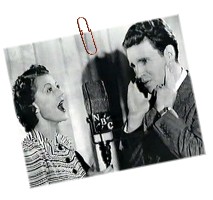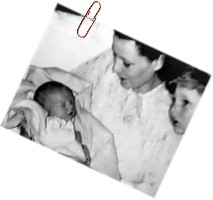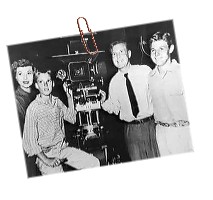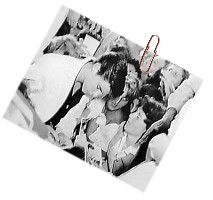 Oswald George Nelson was already a successful bandleader when, in 1932, he signed an up and coming singer to join his act. Her name was Harriet Hilliard, and though they wouldn’t have believed it at the time, they were to become the patriarchs of one of America’s most beloved families.
Having married on October 8th 1935, they were soon welcoming the arrival of their first born, David, a year later on October 24th 1936. Then on the May 8th 1940, Eric Hilliard Nelson was born at the Holy Name Hospital in Teaneck, New Jersey. Oswald George Nelson was already a successful bandleader when, in 1932, he signed an up and coming singer to join his act. Her name was Harriet Hilliard, and though they wouldn’t have believed it at the time, they were to become the patriarchs of one of America’s most beloved families.
Having married on October 8th 1935, they were soon welcoming the arrival of their first born, David, a year later on October 24th 1936. Then on the May 8th 1940, Eric Hilliard Nelson was born at the Holy Name Hospital in Teaneck, New Jersey.The Nelsons place in history was confirmed when on October 8th 1944 they began a radio show that would become the longest running sit-com in U.S. history: The Adventures Of Ozzie & Harriet. After a few episodes it was decided that the show would benefit from the introduction of the couples children, David and Ricky. But instead of the actual David and Ricky, actors were hired to portray them. But it didn’t take long for the boys to persuade their dad that they were more than capable of playing themselves on the show and so, on February 20th 1949 a unique event in occurred on air. A family, portraying themselves, with many referances to events in their own lives. It was in many ways, the worlds first reality show, and listeners were hooked. 
By 1951, Ozzie had in mind a move to televison and began scripting a big screen adaptation which would be a perfect chance to see how people took to seeing the family for the first time. “Here Come The Nelsons” was a hit and convinced Ozzie that television was a viable option. Ever the businessman Ozzie took on the role of producer, director, head writer and story editor of the show which began filming at General Services Studio in Hollywood for ABC and the first episode entitled, The Rivals, debuted on October 3rd 1953. It was to continue for a further 11 seasons and created the stereotypical image of the family of the ‘50’s that survives to this day.
Ricky was 13 by now and had established himself as the “irrepressible Ricky” a wise-cracking kid, who likes nothing more than getting one over on his older, more sensible brother. Off-screen Ricky was developing a keen interest in sports, particularly tennis, for which he reached the semi-finals of the National Indoor Junior Championships at the age of 16. And while a near fatal car accident that same year landed him in hospital with a crackled vertebrae it was to be something totally different that would lure Ricky away from taking up tennis professionally.
Ricky Nelsons entry into the Rock ‘N’ Roll Hall Of Fame, began as a boast to get the attentions of a girl he had taken on date. Whilst driving her home, she began telling Rick how wonderful she thought the guy on the radio was. Elvis Presley was wowing the kids of America like no one before him with his unique sounds and every girl dreamed after him. Rick was no fool, and immediately informed the girl that he too was going to release a record. By the time he got home he had decided that this wasn’t such a bad idea and set about persuading his dad of this. Ozzie duly obliged and Rick recorded a cover of the Fats Domino classic “I’m Walkin’” (The only song which he knew in it’s entirety) To promote the record it was decided that Ricky would perform it on an up-coming episode of the show. On 30th April 1957, “Ricky The Drummer” aired with 16 year old Ricky performing for the first time. A few weeks later teenagers up and down the country were catapulting the single up the charts and Ricky became a Rock ‘N’ Roll star practically overnight. Suddenly the youngest son of America’s favourite family was performing this music, which had long been seen as a bastion of moral evil in homes throughout the states. Ricky was rightly credited with making Rock ‘N’ Roll accessible to millions and changing the opinions of their parents. After all if Ozzie & Harriet approved it couldn’t be as dangerous to the youth of America as people had feared.
Pretty soon Ricky was making personal appearances world-wide and was signed to the Imperial label with a five year contract. His first full album “Ricky” was released in October 1957, reaching the no. 1 spot and spawning such top five hits as “Be Bop Baby” and “Stood Up”. His second album “Ricky Nelson” garnered Ricky his first no. 1 single with “Poor Little Fool” whilst the hunting “Lonesome Town” from his third album “Ricky Sings Again” showed the world that Ricky Nelson had a quality to his voice that belied his young age. In fact Ricky proved very early on that he was certainly not an Elvis wannabe and that he was in fact a serious recording artist with his own unique sense of style and pacing. Never a hip swiveller, Rick was able to portray the vitality of his music just standing at a microphone or with his beloved guitar in front of him.
It was inevitable that the movies would pick up on the box office potential of this latest teenage idol (a phrase first coined to describe Rick!) and sure enough in 1958 Rick began filming “Rio Bravo” a big screen western directed by the legendary Howard Hawkes and co-starring John Wayne, Dean Martin and a young Angie Dickinson. As Colorado, the sharp shooting gun slinger who joins Wayne and Martin in defending the law, Ricky gave a solid performance and even managed to duet with Dino on “My Rifle, Pony And Me”. However it was clear that acting was not the great passion in Rick’s life, perhaps because he had been so used to reading his lines off hidden prompt cards on the set of the T.V. show for all those years. It was brother David who had to stop Rick from practising his shooting and horse-riding and coach him on his lines! Never the less the movie became a classic of the genre and ensured that Ricky would return to the screen two years later in “The Wackiest Ship In The Army” starring alongside Jack Lemmon.
In 1961 his 6th album Rick is 21, declared to the world that the teenage idol was now a man with a letter less in his name but with a new woman at his side. Kristin Harmon had first in the proceeding years she had become an attractive 16 year old. The Nelsons and the Harmons were family friends and the blossoming relationship between the pair was met with aproval on both sides, by 1963 they were married and Kris, together with her new sister-in-law June Blair, became the on-screen wives of the Nelson boys. In 1963 Rick’s contract with Imperial had ended and he signed with Decca Records for a then un-heard of 20 year contract.
In February 1967, the final episode of “The Adventures Of Ozzie And Harriet” aired. After over 22 years on radio and television and having seen the boys grow from pre-teens to married men, the world said goodbye to the family a generation had grown up with. On top of that his music was no longer selling as well as it had. His first few albums for the label had continued to ride the charts but the sixties was proving to be a time when many in American music were displaced by the sudden and all consuming rise in popularity of the English sound, led by the Beatles. Like many of his contemporaries, Elvis included, Rick began to find it increasingly difficult to get his music played on the radio. Subsequently he began to search for new directions to take his music. It was this willingness to not just accept, but embrace change, that kept Rick fresh during this difficult period in his career. Though not as commercially successful as he would have liked, his albums of this period proved to be an important learning curve for Rick in which he experimented with country music and the style of new idols like Bob Dillon. This was also the beginning of Rick’s songwriting career. Up to now Rick had left that side of his career to others, there was hardly a lack of good songs sent to him at the time and when you have major talents like Jerry Fuller, Dorey Burnette and Baker Knight penning classics like “A Wonder Like You”, “Lonesome Town” and “It’s Late”, especially for you, who would blame him? But as Rick began exploring different sides of music, he began penning his own classics, such as one of his most poignant tracks “Easy To Be Free”. Featured on his live at the Los Angeles Troubador album it was a mature and thought provoking piece of work which heralded the arrival of Rick Nelson and the Stone Canyon Band.
The Stone Canyon Band included Tom Brumley, Bobby Neal, Pat Woodward, Andy Chapin and Rick Intveld. They were pioneers of what became known as Country Rock. With two superb albums “Rick Sings Nelson” and “Rudy The Fifth”, he had transformed himself completely from the young teen heartthrob of the fifties into the songwriter and lead singer of a credible and ground-breaking band. The critical raves heaped on these albums however was not matched in chart success.
|